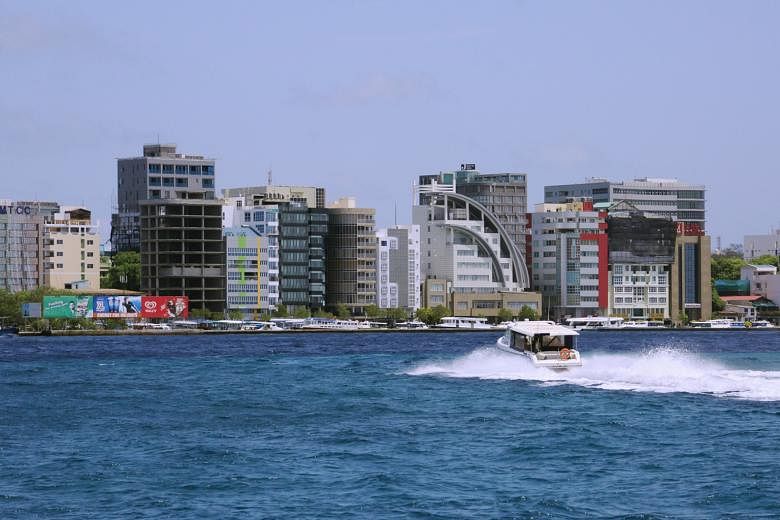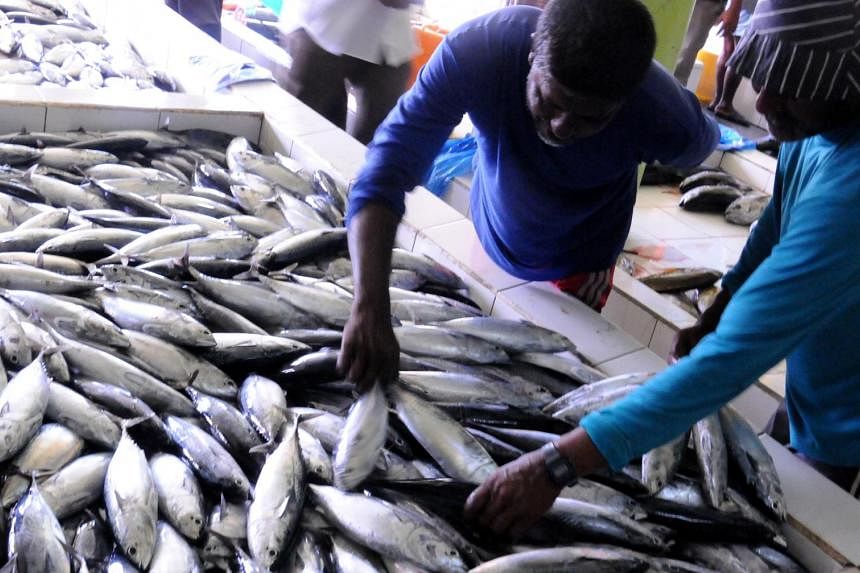There was a time Maldives master fisherman Adam Naseer could catch as many skipjack tuna with a pole and line as he could handle. But as the world warms, life is no longer that simple.
Sitting at a roadside stall on Fonadhoo island in the middle of the Indian Ocean, the 45-year-old, who was captain of his own boat when he was 13, reflects on the challenges fishermen face as rising sea temperatures force the precious tuna out of their reach.
With global warming they face related phenomena such as abrupt weather shifts, changes in fish migration patterns, and intense storms and waves, all coupled with a creeping rise in sea level.
With around 70 per cent of the native Maldivian population still involved in fishing, the signs are ominous for the country's second biggest earner after the US$2.3 billion (S$3 billion) tourism sector.
"Maldivians are actually observing things related to climate change," Mr Moosa Zeeban Saeed, an assistant director at the Maldives' Ministry of Environment and Energy's department of climate change, said in an interview in the capital Male.
Lately, the fishermen have noticed that their ancient indigenous weather prediction system, Nakaiy Nevi, which has for generations predicted local weather and ocean conditions with near-pinpoint accuracy, is no longer reliable.
Mr Adam Naseer has adapted. He now pays the equivalent of US$130 a month to the Fishermen's Association, which buys information from a US satellite on key indicators such as ocean currents, surface temperature and prevailing surface winds.
Mr Ali Wafir Adam, a former journalist on the island who monitors the data and sends updates to subscribers, said that last year, the temperature of the ocean surface - the top 30m - never rose above 31 deg C. But this year, in April, it hit 35 deg C. Tuna, the staple catch and export of the Maldives, do not like temperatures above 29 deg C, and tend to avoid the surface when it gets that warm. It's a worry, said a grave-faced Mr Naseer.
But in the world's lowest-lying country, where more than 80 per cent of land is less than 1.6m above sea level, survival for all 350,000 inhabitants has always hung by a thread.
When the water desalination plant in Male - the capital protected by sea walls and breakwaters - caught fire in December last year, the city of more than 100,000 ran out of water in a few days. India, Bangladesh and Sri Lanka had to respond with airlifts and ships loaded with fresh water while the plant was repaired.
The Maldives is not alone. Low-lying atoll nations in the Pacific Ocean as well - like Kiribati and Tuvalu and the Marshall Islands - are just barely above sea level, mere protuberances on high ocean ridges.
They are inherently vulnerable, with populations and islands widely dispersed; almost totally dependent on imports from great distances; and with limited fresh water under threat from sea water intrusion.
Ironically, these islands contribute a tiny fraction of global carbon dioxide and greenhouse gas emissions, yet they will be among the first to suffer from the effects of global warming.
Mass relocation remains a last resort. The people of the small island states would prefer to adapt. Consolidating far-flung populations on safer islands is one option.
Resilience and adaptation have become buzzwords. But there are many competing challenges - education and healthcare for instance - in a geography that comprises vast stretches of ocean. The Maldives for instance, spends around US$64 million a year just on safe harbour projects.
For the small island states, the actual extent of sea level rise may, beyond a point, become irrelevant. They already face climate change threats on many fronts, which will be exacerbated by a rise of even a few centimetres in sea level.
This is the message the Maldives brings to the table as chair of
the 44-member Alliance of Small Island States, representing their collective interest at climate change talks.
"When you talk about the Marshall Islands, Tuvalu, Kiribati; we are the countries on the front line, we are in the most danger," the Maldives' deputy permanent representative to the United Nations, Mr Jeffrey Salim Waheed, said from New York.
In mid-level global warming scenarios, the Maldives will likely experience a sea level rise of around half a metre by about 2100, swallowing up to 77 per cent of its land area. If the sea level rises by 1m, the Maldives could be almost completely inundated by about the year 2085.
But well before the sea drowns the string of islands and atolls, the effects of a warming world are already apparent.

"We live in a dynamic environment and the vulnerability is always there," said Mr Abdulla Ziyad, the Maldives' Minister of State for Environment and Energy, in an interview in Male. "But in recent times we have seen turbulent and unpredictable weather."
The amount of rainfall the Maldives receives is the same as ever - but the onset of rainfall is more sudden and the rain more concentrated.
In a country comprising around 99 per cent water, the people of the Maldives are used to a dynamic, shifting environment constantly at the mercy of the ocean.
The islands' shorelines change over the years and some may even grow, says Dr Paul Kench, head of the University of Auckland's School of Environment.
Dr Kench's research on atolls and islands has shown that sand, made up essentially of dead and fragmented coral, can wash up on an island and add land mass. Some coral can also adapt rapidly to warming seas, a new study suggests.
Dr Kench cautions against the assumption that the Maldives would disappear in 50 to 100 years.
"We've seen islands becoming smaller, but we've also seen parts of islands becoming bigger, building vertically and horizontally," he said. "What sea level does is reasonably important. What's more important is sand availability and how that is going to shape islands."
But in Male, the western part of the island is so low that spring tide sea water comes up through drains and floods the roads. Heavy downpours almost immediately flood much of the city. The only thing possible was to build a higher wall, Dr Kench said. "Male's only future is an engineered one."
In New York, though, Mr Waheed insisted that "the way we are going now, if nothing changes, if we are not able to make a difference, we are looking at a 4- to 5 deg C increase in global temperature."
"People ask, is that a lot? It basically will be the destruction of almost every country that the Maldives currently represents as chair of the Alliance of Small Island States."
Meanwhile, there are other issues associated with climate change that the Maldives must worry about and try to adapt to.
"It is not sea level rise that is going to get us first," Mr Waheed told The Straits Times. "What's going to get us first is tidal variations, changes in weather patterns and extreme weather events."
"Global warming will affect every country, not just the Maldives. But the Maldives is just the lowest-lying country in the world and it will get us first," he said. "We don't have a single piece of land above 3m."
Science is only beginning to understand the hugely complex environment of oceans and coral atolls.
But on the island of Fonadhoo, not far from where Mr Naseer sits, there is no need for a scientific study as a house totters, falling slowly but surely into the sea. The hungry waves have broken its walls apart, and crabs scuttle over the half-submerged slabs.
The water does not have to rise much for high tide or storm surges to reach the homes nearby. The thin line between sea and survival that the Maldives perches on, is measured in centimetres.


